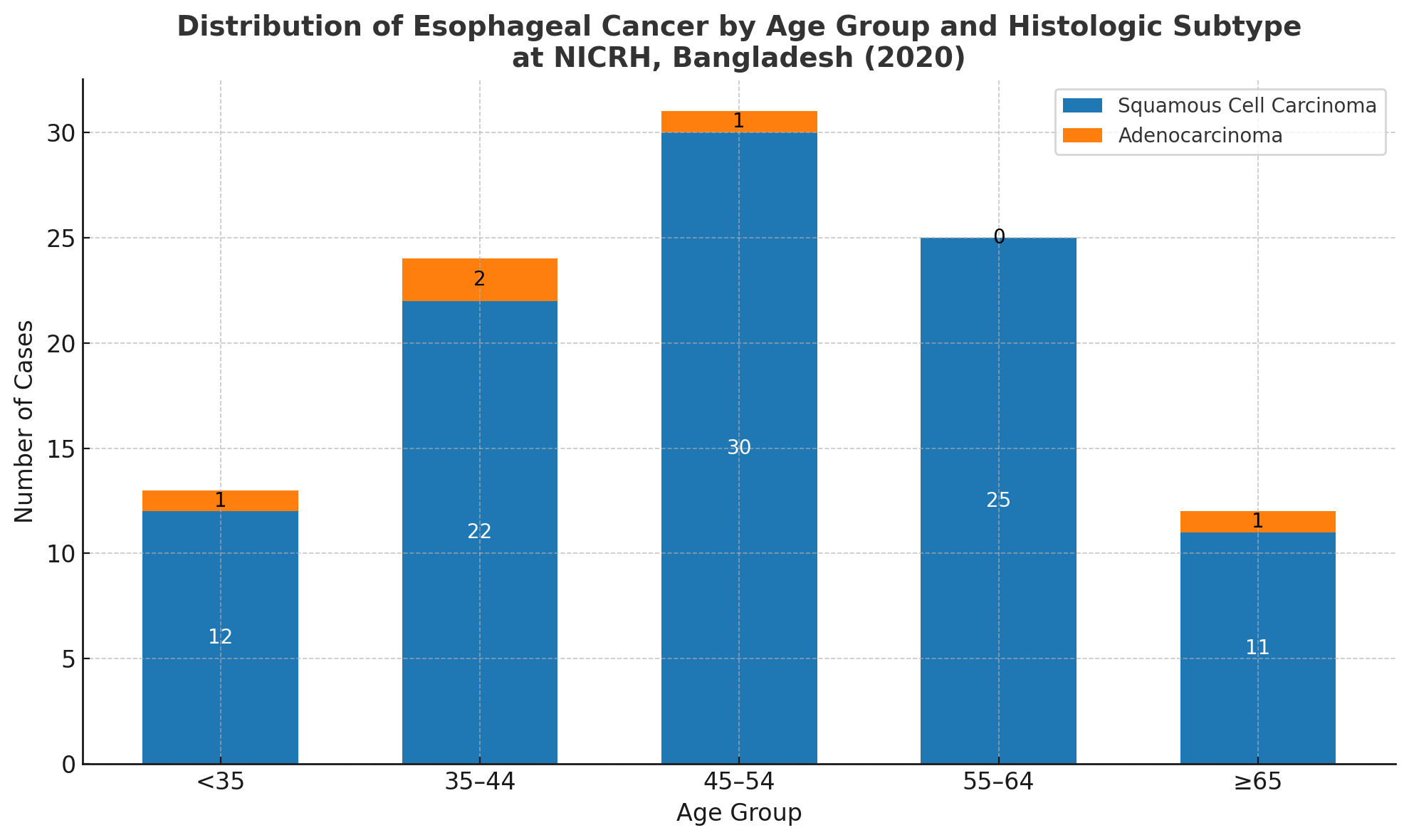Tuesday Poster Session
Category: Esophagus
P4903 - Epidemiologic Landscape of Esophageal Cancer in Bangladesh: Insights From the National Institute of Cancer Research and Hospital (NICRH) Registry
Tuesday, October 28, 2025
10:30 AM - 4:00 PM PDT
Location: Exhibit Hall

Prince Shah-Riar, MD (he/him/his)
DHR Health, Edinburg, Tx
Edinburg, TX
Presenting Author(s)
Priyam Karmakar, MBBS1, Md. Mokbul Hossain, BSc, MSc1, Abhijeet Roy, MBBS, MSc2, Prince Shah-Riar, MD3, Nadia Smita, 4, Asif Zamir, MD, FACG5
1BRAC James P Grant School of Public Health, BRAC University, Bangladesh, Dhaka, Dhaka, Bangladesh; 2Georgia State University, Avondale Estates, GA; 3DHR Health, Edinburg, Tx, McAllen, TX; 4University of Texas Rio Grande Valley, Edinburg, TX; 5DHR Health Gastroenterology, Edinburg, TX
Introduction: Esophageal cancer remains one of the most lethal malignancies globally and ranks among the top five cancers in Bangladesh. In the absence of a national cancer registry, hospital-based data provide the only available lens into disease burden. This study aimed to assess the prevalence, demographic distribution, and histologic profile of esophageal cancer in Bangladesh using data from its largest oncology center.
Methods: Data from the 2020 registry of the National Institute of Cancer Research and Hospital (NICRH) were analyzed. Patients with confirmed or provisional cancer diagnoses were included. Esophageal cancer cases were stratified by age group, sex, and histologic subtype based on histopathological records.
Results: Of 26,202 outpatient visits, 11,203 (42.8%) had a confirmed or provisional diagnosis of cancer. Gastrointestinal (GI) malignancies comprised 22.8% of all cases, with esophageal cancer accounting for 19.7% of GI cancers and 4.5% of total cancers—ranking fourth overall and second among males. The 55–64 age group had the highest disease burden. Histologically, 92.6% were squamous cell carcinoma, followed by 7.3% adenocarcinoma. Among patients over 65, esophageal cancer was the second most common malignancy, with a prevalence of 7.3%.
Discussion: Esophageal cancer constitutes a significant and under-recognized public health challenge in Bangladesh. Its predominance among older adults and males, coupled with late-stage presentation, underscores the urgent need for a population-based cancer registry and targeted early detection strategies. These findings can inform screening programs and health policy in resource-limited settings.

Figure: Distribution of Esophageal Cancer by Age Group and Histologic Subtype at NICRH, Bangladesh (2020)
Disclosures:
Priyam Karmakar indicated no relevant financial relationships.
Md. Mokbul Hossain indicated no relevant financial relationships.
Abhijeet Roy indicated no relevant financial relationships.
Prince Shah-Riar indicated no relevant financial relationships.
Nadia Smita indicated no relevant financial relationships.
Asif Zamir indicated no relevant financial relationships.
Priyam Karmakar, MBBS1, Md. Mokbul Hossain, BSc, MSc1, Abhijeet Roy, MBBS, MSc2, Prince Shah-Riar, MD3, Nadia Smita, 4, Asif Zamir, MD, FACG5. P4903 - Epidemiologic Landscape of Esophageal Cancer in Bangladesh: Insights From the National Institute of Cancer Research and Hospital (NICRH) Registry, ACG 2025 Annual Scientific Meeting Abstracts. Phoenix, AZ: American College of Gastroenterology.
1BRAC James P Grant School of Public Health, BRAC University, Bangladesh, Dhaka, Dhaka, Bangladesh; 2Georgia State University, Avondale Estates, GA; 3DHR Health, Edinburg, Tx, McAllen, TX; 4University of Texas Rio Grande Valley, Edinburg, TX; 5DHR Health Gastroenterology, Edinburg, TX
Introduction: Esophageal cancer remains one of the most lethal malignancies globally and ranks among the top five cancers in Bangladesh. In the absence of a national cancer registry, hospital-based data provide the only available lens into disease burden. This study aimed to assess the prevalence, demographic distribution, and histologic profile of esophageal cancer in Bangladesh using data from its largest oncology center.
Methods: Data from the 2020 registry of the National Institute of Cancer Research and Hospital (NICRH) were analyzed. Patients with confirmed or provisional cancer diagnoses were included. Esophageal cancer cases were stratified by age group, sex, and histologic subtype based on histopathological records.
Results: Of 26,202 outpatient visits, 11,203 (42.8%) had a confirmed or provisional diagnosis of cancer. Gastrointestinal (GI) malignancies comprised 22.8% of all cases, with esophageal cancer accounting for 19.7% of GI cancers and 4.5% of total cancers—ranking fourth overall and second among males. The 55–64 age group had the highest disease burden. Histologically, 92.6% were squamous cell carcinoma, followed by 7.3% adenocarcinoma. Among patients over 65, esophageal cancer was the second most common malignancy, with a prevalence of 7.3%.
Discussion: Esophageal cancer constitutes a significant and under-recognized public health challenge in Bangladesh. Its predominance among older adults and males, coupled with late-stage presentation, underscores the urgent need for a population-based cancer registry and targeted early detection strategies. These findings can inform screening programs and health policy in resource-limited settings.

Figure: Distribution of Esophageal Cancer by Age Group and Histologic Subtype at NICRH, Bangladesh (2020)
Disclosures:
Priyam Karmakar indicated no relevant financial relationships.
Md. Mokbul Hossain indicated no relevant financial relationships.
Abhijeet Roy indicated no relevant financial relationships.
Prince Shah-Riar indicated no relevant financial relationships.
Nadia Smita indicated no relevant financial relationships.
Asif Zamir indicated no relevant financial relationships.
Priyam Karmakar, MBBS1, Md. Mokbul Hossain, BSc, MSc1, Abhijeet Roy, MBBS, MSc2, Prince Shah-Riar, MD3, Nadia Smita, 4, Asif Zamir, MD, FACG5. P4903 - Epidemiologic Landscape of Esophageal Cancer in Bangladesh: Insights From the National Institute of Cancer Research and Hospital (NICRH) Registry, ACG 2025 Annual Scientific Meeting Abstracts. Phoenix, AZ: American College of Gastroenterology.
